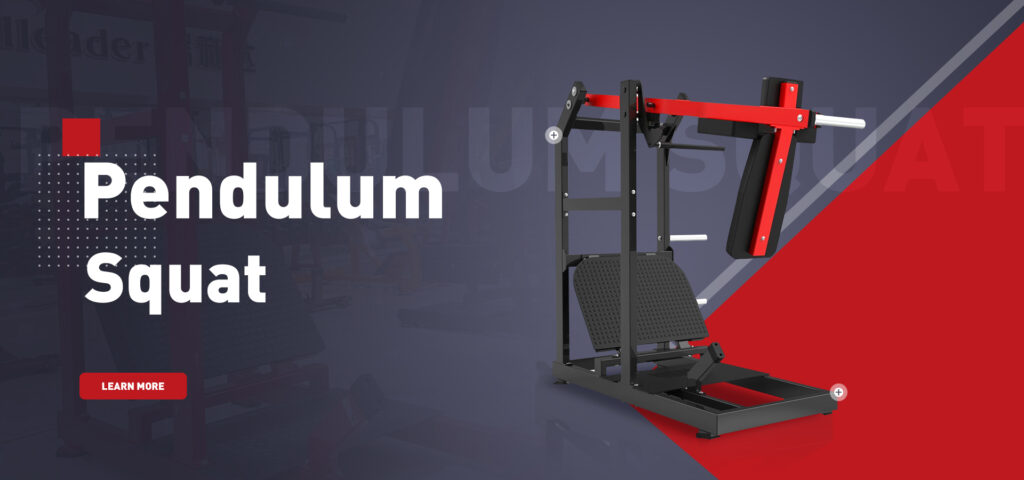If you’re serious about leg training, you’ve probably been through the classic leg day exercises—squats, deadlifts, and leg presses. But if you’re looking for something that targets your legs differently while also helping you get stronger and more defined quads, the pendulum squat is a game-changer.
In this post, we’ll cover everything you need to know about the pendulum squat—its benefits, the proper technique, and how it can help you build stronger legs. So, whether you’re new to this exercise or looking to maximize your results, we’ve got you covered.
What is a Pendulum Squat?
The pendulum squat is a machine-based exercise that provides a unique, controlled range of motion to help you focus more on your quads. Unlike traditional squats, which require a lot of balance and core stability, the pendulum squat machine keeps your body supported, allowing you to concentrate on your leg muscles without stressing your lower back or joints.
The machine works by swinging in an arc, which mimics the motion of a pendulum. This movement allows you to squat deeper than you might be able to with free weights, engaging your leg muscles throughout the full range of motion.
Why Should You Add Pendulum Squats to Your Routine?
The pendulum squat is more than just a variation of the traditional squat—it’s a powerhouse exercise that offers several key benefits, especially for leg development. Here’s why it deserves a spot in your workout routine:
Targets Quads Like No Other Exercise
While traditional squats work a variety of muscles in your lower body, the pendulum squat machine is designed to isolate and emphasize your quadriceps. This makes it a great choice if you want to focus on building stronger, more defined quads.
Reduces Strain on Your Lower Back
Many people experience lower back strain when performing barbell squats, particularly if their form isn’t perfect. The pendulum squat eliminates much of this risk because the machine supports your upper body, allowing you to squat deeply without putting unnecessary stress on your spine.
Joint-Friendly Movement
Unlike some free-weight exercises that can place stress on your knees or hips, the pendulum squat machine provides a controlled, joint-friendly movement. This makes it a great option for anyone dealing with joint pain or looking to reduce the wear and tear on their knees while still getting an intense leg workout.
Encourages a Full Range of Motion
One of the standout benefits of the pendulum squat is the ability to achieve a full range of motion. This means you can squat deeper, activating more muscle fibers in your quads and glutes, leading to better muscle development over time.
Constant Muscle Tension
Throughout the entire movement, the pendulum squat provides continuous tension on your muscles. Unlike free-weight squats, where tension can decrease at the top of the movement, the pendulum squat keeps your quads working hard from start to finish.
Great for Beginners and Advanced Lifters
Whether you’re a beginner learning the ropes of leg training or an advanced lifter looking to push your limits, the pendulum squat is effective for all fitness levels. The machine’s design helps beginners maintain proper form, while more experienced lifters can use it to lift heavy without the added stress of balancing free weights.
Perfect for Progressive Overload
Progressive overload—gradually increasing the weight you lift over time—is key to muscle growth and strength gains. The pendulum squat machine makes it easy to track your progress and increase the weight as you get stronger.
How to Perform the Pendulum Squat Correctly
To get the most out of the pendulum squat, proper form is crucial. While the machine helps guide you through the movement, focusing on your technique ensures you’re hitting the right muscles and avoiding injury.
Here’s how to do the pendulum squat step by step:

Step 1: Set Up the Machine
Start by adjusting the pendulum squat machine to fit your body. Position the shoulder pads and footplate so you’re comfortable. Step onto the footplate with your feet about shoulder-width apart, or slightly wider if that feels more natural for you.
Step 2: Position Yourself Correctly
With your shoulders snug against the pads and your feet firmly planted, brace your core. Keep your chest up and maintain a neutral spine throughout the movement. This will help you stay stable and avoid unnecessary strain on your lower back.
Step 3: Begin the Descent
Slowly lower yourself into the squat by bending your knees and pushing your hips back. The machine’s pendulum-like motion will guide your body. Focus on getting deep into the squat, aiming to bring your thighs below parallel.
Step 4: Push Back to Starting Position
Once you reach the bottom of the squat, press through your heels and push yourself back up to the starting position. Make sure to fully extend your legs without locking your knees.
Step 5: Repeat
Complete your desired number of reps, keeping the movement controlled and smooth. You should feel a significant burn in your quads by the end of your set.
Common Mistakes to Avoid
- Wrong Foot Placement: Avoid placing your feet too far forward or too far back on the footplate. Keeping your feet firmly planted and pushing through your heels will ensure your quads are properly engaged.
- Rushing the Movement: Pendulum squats are most effective when done with a slow and controlled tempo. Don’t rush through the reps—focus on smooth, controlled motion to maximize muscle engagement.
- Skipping the Full Range of Motion: A common mistake is not squatting deep enough. To get the full benefit of the exercise, make sure you’re going as low as your body comfortably allows.
Using the Pendulum Squat to Build Leg Strength
To build stronger legs using the pendulum squat, it’s important to incorporate it into your workout routine strategically. Here’s how you can do that:
Train with Consistency
For best results, train your legs consistently. If you follow a typical workout split, aim to include pendulum squats in your leg routine once or twice a week. Use it as a primary exercise or an accessory movement after heavy lifts like barbell squats.
Adjust Your Sets and Reps
For strength gains, focus on lower reps with heavier weights. Try doing 3-5 sets of 5-8 reps, ensuring you’re challenging yourself with each set. If you’re working more on hypertrophy (muscle growth), you can increase the reps to 8-12 per set.
Progressive Overload
To see progress, you’ll need to consistently increase the weight as you get stronger. Track your lifts and aim to increase the resistance every few weeks, while always maintaining proper form.
Balance with Other Exercises
While the pendulum squat is excellent for targeting the quads, make sure you’re also training your glutes, hamstrings, and calves. Incorporate exercises like lunges, Romanian deadlifts, and hamstring curls for a complete lower-body workout.
FAQs on Pendulum Squat
1. Is the pendulum squat better than traditional squats?
The pendulum squat specifically targets your quads and reduces strain on your lower back, making it a great complement to traditional squats but not necessarily a replacement.
2. Can beginners use the pendulum squat machine?
Yes! The pendulum squat machine is beginner-friendly, helping you maintain proper form while focusing on your legs without the need for balancing weights.
3. How often should I do pendulum squats?
For optimal results, include pendulum squats in your leg workout 1-2 times per week, depending on your training goals and overall routine.
Final Thoughts
The pendulum squat is an incredible tool for building stronger legs, particularly when it comes to targeting your quads. Its ability to isolate muscles, provide continuous tension, and reduce strain on your lower back and joints makes it an essential part of any leg day routine.
Whether you’re a beginner looking for a safer squat variation or an experienced lifter aiming to increase leg strength, the pendulum squat can help you reach your goals. By incorporating this exercise into your workout, focusing on proper form, and applying progressive overload, you’ll see serious improvements in your leg strength and muscle definition.
Try adding pendulum squats to your next leg workout and experience the difference for yourself!














